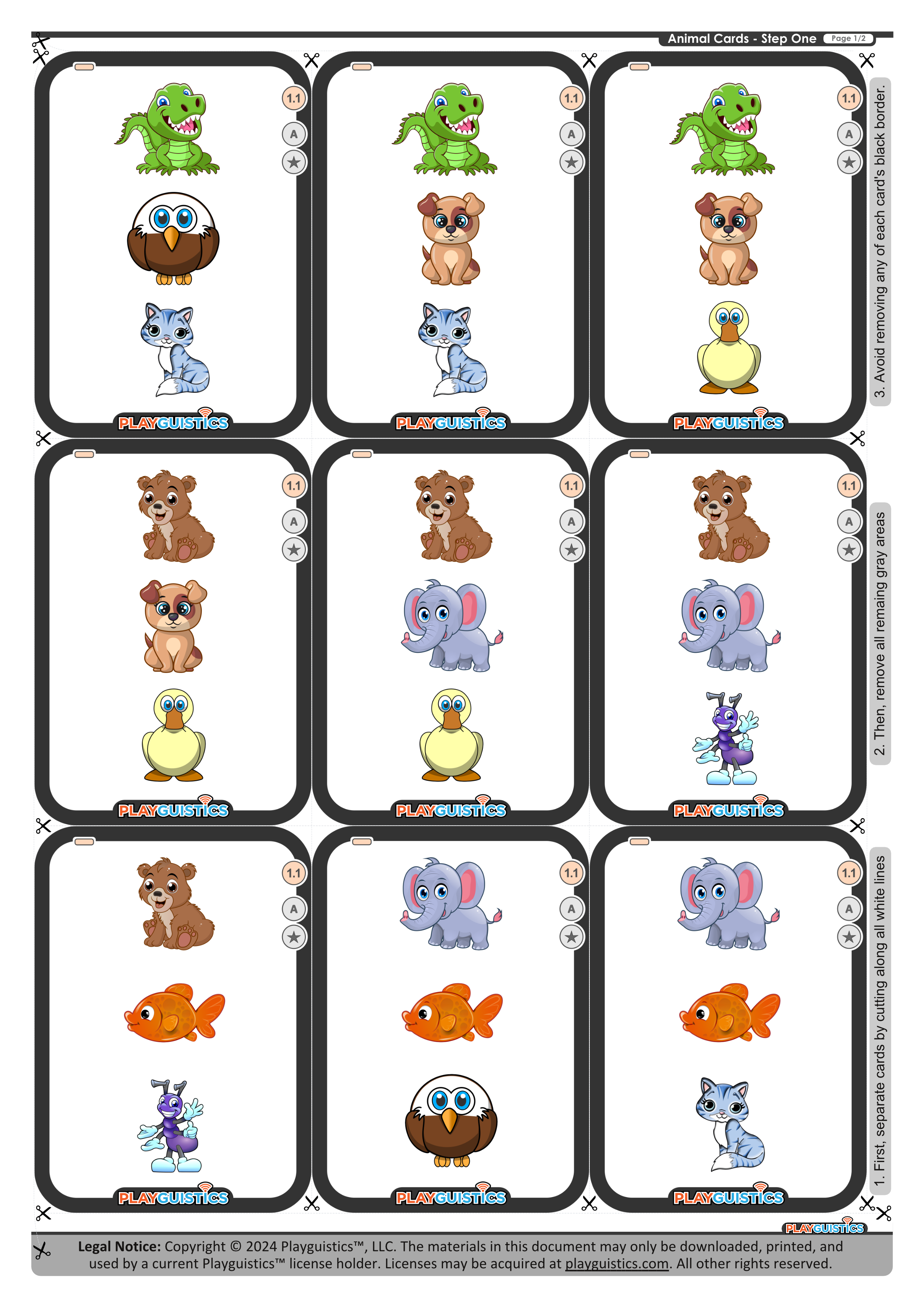How To Use Deduction Cards
The following instructions apply to ALL of our deduction card games. Although these card games vary in theme and level of complexity, the same methods of printing/preparation and the recommended process for introducing the games to students are consistent across all of the deduction card games we have created.
|
Game Play
Deduction Cards Games are best utilized as a two-partner activity. In these instructions, Partner One is always the "asker" and Partner Two is always the "answerer."
Partner One will place a set of similar but different cards in front of themselves, all face-up. Usually, each set has between 9 and 27 cards, but sometimes there may be more.
Partner Two will have one card, which is an identical match to one of the cards in front of Partner One. They must draw this card randomly from a second set of cards that is identical to the set laid face-up in front of Partner One.
Partner One must ask Partner Two questions about the single "secret card" in their possession. Based on Partner Two's answers to their questions, Partner One systematically turns any cards face-down that logically CAN'T match Partner Two's "secret card."
This continues until only one card remains face-up in front of Partner One. Partner One can then ask "Is this your card?"
Partner Two will then reveal their "secret card" and the two partners can determine whether Partner One has successfully deduced the correct card.
|

|
Preparation Instructions
|
Printing
Follow the following instructions to print the cards for any Playguistics Deduction Card Game.
1. Print the Card-Fronts
There are two recommended options for printing and preparing the cards for Deduction Card games.
- Print the PDF document provided onto printer-friendly cardstock.
Or
- Print the PDF document provided onto regular printer paper (and later laminate the individual cards for longlasting durability).
If printing on cardstock, 300g cardstock is recommended, but any weight 200g or above will be sufficient.)
2. Print the Card-Backs (Optional)
To create a more professional looking set of cards, consider making the cards double-sided. After printing the card fronts, you can print card-backs too.
- After printing the card-fronts, simply flip the print-out over and reprint the card-backs on the other side of the same sheet of printer paper or cardstock.
Important Note! For all deduction card games, you'll need at least two copies of each set of cards.
To help avoid mixing up otherwise identical sets of cards, 8 different versions of each set are provided, each with a different symbol (such as a 'star' or a 'sun' symbol) on the upper-right side of each card to make it easier to sort the cards if they get mixed up.
However, to make sorting even easier, we offer a variety of different files for printing card-backs. You can print a different type of card-back on each of your card sets to make it super easy to tell each set apart from the others.
|

|
|
Preparation
After printing, cut out each of the individual game cards.
- Cut out each card from the front-side of the sheet. The front-side is the side that shows individual cards, all with their own thick black outline.
- Just in case the printing alignment isn't 100% perfect, the card-backs printing choices are always a pattern that fills the entire printing area and provides an extra thick printing bleed around each card.
|

|
Printable PDF Document Example
Two identical sets of the same 9 animal deduction cards, one set marked with 'stars' and the other marked with 'suns.'
|
 |
 |
| Visit This Activity's Page |
Introducing Games to Students
The following steps are a recommend process for introducing our deduction card games to students. If you've never used a deduction card game during classtime before, this introduction process is a great one to try first. However, the method provided below is just one of many possible methods. Teachers are encouraged to use whichever method they believe is best for students.
|
Presentation
Use flashcards to ensure that your students know the vocabulary words used in the game. Each Deduction Card Game activity Information Page will provided lists of all the words that students need to know to fully participate in the game.
There will be some lists of Core Vocabulary Words that students need to know for each of the available sets of cards. These should be taught with flashcards.
There will also be a list of Vocabulary Best Learned In Context, which are always used for the game, no matter which set of cards you are using. These words don't generally need to be pre-taught. They'll be used in the sentence structures used for communication while enjoying the activity, but students will be able to learn these words from context.
|

|
| Examples of Word Lists for a Deduction Card Activity |
| Vocab Best Learned In Context (And Used with All Card Sets Below) |
a/an, card, do, have, is, isn't, it, no, secret, this, yes, you, your |
| Core Vocab (Card Set A) |
alligator, ant, bear, bird, cat, dog, duck, elephant, fish |
| Core Vocab (Card Set B) |
kangaroo, octopus, monkey, mouse, rabbit, turtle |
| Core Vocab (Card Set C) |
alligator, ant, bird, cat, dog, duck, fish, horse, lion, octopus |
|
Practice
The best way to teach Deduction Card Games is to simply demonstrate them. Even if you do not speak a language that your students can understand (or are prohibited from doing so by policy where you work), you can provide a demonstration of game rules that your students will understand by following these simple steps.
Materials Setup
- Lay out one set of the provided cards on the table, face-up. (For example, the set marked with "stars.")
- Leave a second set of the provided cards in a stack, face-down. (For example, the set marked with "suns.")
- Draw the top card from the second set of cards (the face-down stack with "suns"). We will refer to this card as the "secret card."
- Lay the secret card on the table face up (far away from the other set of face-up cards (with stars) so that your students will understand that it has a separate purpose).
Teacher-Only Demonstration
- Verbalize questions about the secret card using the recommended questions sentence pattern provided on the Information Page for each Deduction Card Game.
Insert different words from the core vocabulary word list provided for the activity.
For example, the Deduction Card Game that uses the example materials shown above (for learning about animals) uses the following recommended sentence pattern:
"Do you have a _________________?"
Game participants can use this sentence to ask questions such as the following:
"Do you have an elephant?"
or
"Do you have a fish?"
- Show your students how to use logic to narrow down which card from the set of face-up cards matches the secret card.
If you ask "Do you have a dog?" and the secret card has a dog pictured on it, then answer your own question with "Yes, I do." and then show your students how to "eliminate" the non-matching cards by turning any card without a dog face-down.
If you ask "Do you have a dog?" and the secret card does not have a dog pictured on it, then answer your own answer with "No, I don't." and then show your students how to "eliminate" the non-matching cards by turning any card with a dog face-down.
Continue this process until you've narrowed down the (initially) face-up cards to just one remaining face-up card. This last remaining face-up card should match the secret card.
Structured Demonstration With 1 Student
- Now invite one student to join you to again demonstrate a round of this game, but with two players this time.
- Turn the first set of cards face up again.
- Shuffle the secret card back into the stack of potential secret cards and draw a new secret card. However, this time DO NOT show it to your students. Instead, keep it a secret, dramatically and humorously hiding it from view to emphasize that it is a secret that should not be showed to the other player.
- Coach the student to ask you questions using the activity's recommend sentence pattern for asking questions and inserting different words from the core vocabulary word list provided for the activity into the sentence pattern's blank.
- Answer each question from the student with "Yes, I do." or "No, I don't." and coach them on how to turn over the non-matching cards.
- After the student (with your help) narrows down the matching card from the cards laid out in front of them, repeat the game with other students until the group as whole has a basic understanding of how to play the game.
Supported 2 Student Practice
- Now invite a student to be the holder of the secret card and another student to play the other role in the game (asking questions to logically deduce the matching card).
Sit next to and a little behind the student with the secret card so that you can help them correctly answer the other student's questions with "Yes, I do." or "No, I don't."
- Continue practice rounds like this while gradually reducing your direct involvement and coaching until the students seem to understand the activity enough to be able to play it in partner-pairs independently.
|

|
|
Production:
Now that your students understand how to play the game, divide them into partner-pairs and invite them to alternate taking turns playing both roles in the game. As the teacher, if there is an uneven number of students, you can be one of the students' partner-pair.
However, it's best at this point if you are free to circulate around the classroom to observe and monitor your students' progress. Be sure to keep a sufficient distance from your students to allow them a sense of independence and don't be too quick to jump in and correct minor errors.
The best approach at this point in the students' learning is that they build their confidence and become very comfortable with constructing useful sentences and immediately correcting every small mistake will be counter-productive.
|

|
Want to try out some of our
Deduction Card Games?

Click here to schedule a free
live one-on-one demo session with
a member of our support team.
|
Tips & Tricks
- While the instructions above suggest playing Deduction Card Games as two-partner activities, you also have the option to enjoy them as two-group activities.
For example, if you have some students who are less confident in their abilities, you can place them in a group with a more confident student.
Each group of 2 or more students can together play one of the two roles for these activities (either the asker or the answerer).
- Some Deduction Card Games have different sets of cards for different vocabulary lists. Usually, these different sets share the same activity name (such as "Animal Deduction Cards), but are differentiated with different letters.
For example, there are several different sets of deduction cards for different lists of animals. These separate sets share the same topic, but are labeled A, B, C, etc.
To create more variety and a higher level of challenge, the card sets from separate Steps can be combined to create larger and more varied sets of cards.
For example, the 9 cards from Animal Deduction Cards Set A can be combined with the 9 cards from Animal Deduction Cards Set B to create a larger set of 18 cards.
Note: It will be easy to separate the cards later, using the letters that the cards are marked with on the upper right side of each card. For example, the Step A cards are marked A and the Step B cards are marked B.
- Deduction Card Games are great for classroom practice, but some students and their parents may enjoy playing them at home for extra "out-of-class" practice.
Feel free to share the PDF print-files for any of these games with your students' parents so that they can make their own cards to practice their English speaking skills at home.
- To reduce the number of sets of cards you need to print out to involve all of your students in a Deduction Card Game, you can have all of the participants playing the role of Partner Two draw their secret cards from just one set of cards.
This way, you'll only need one set of cards per partner pair/group, plus one extra set of secret cards, instead of two complete card sets per partner pair/group.
|

|
|
Important Note
The above instructions are provided as suggestions for best practices. However, the teacher should always be the ultimate decision-maker about which communication approaches are best suited to a particular student / group of students.
Teachers are encouraged to modify the recommended steps for introducing deduction card games if they believe that there is be a better way to explain the game rules to their students.
|









